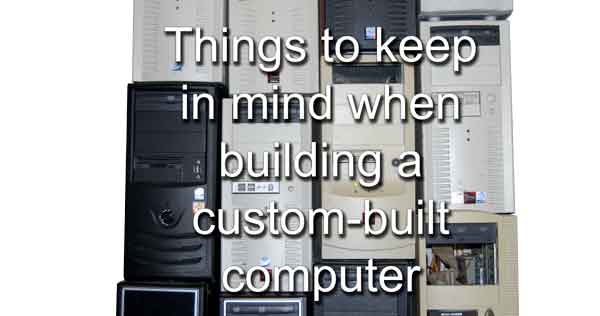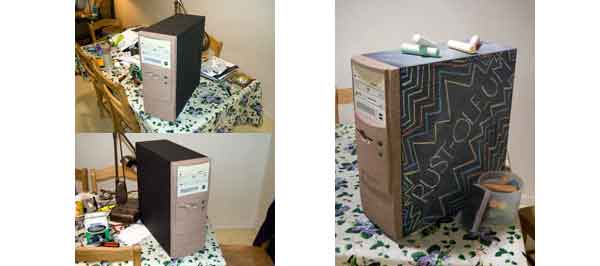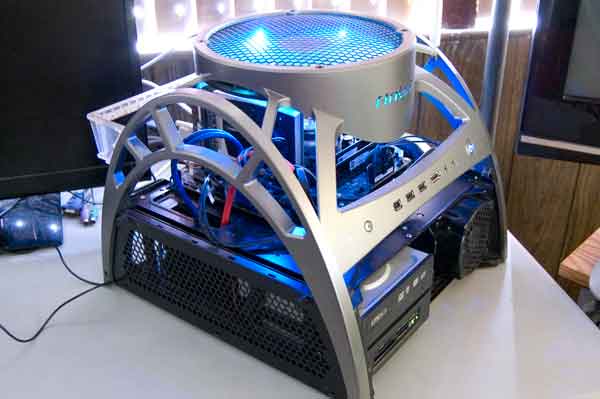Updated January 10, 2024
So, you are thinking about building a computer. There are a lot of things you have to choose. So here are a few things to keep in mind when assembling your custom-built computer.

Building your system can be pretty satisfying, like being able to say, "I built it myself". And you can also perform any service on it since you know the location of all the components.
But if you do not plan it out, it can be a nightmare. For instance, if you have to return incorrect components. It can be a real headache if you order them online and have to ship them back.
So, let's take a look at some of the details you have to consider before purchasing the components for your custom-built computer.
Form vs. Function
It is an age-old problem: Form vs. Function. Do you want a system that is incredible looking or takes up very little space (Form)? Or maybe a system that can run intense graphic games or can hold a ton of components (Function)?
Over the years, I have built both types of computers for my personal use. My first few were made purely for function, playing games, and a ton of storage using a RAID (Redundant Array of Independent Disks).
They were big and not very pretty to look at, but they served the purpose. But systems like that have one big issue: cooling. Trying to keep all of the components at a reasonable temperature was tough.
Now a few years ago, I decided that I was tired of having to leave the side panel of my computer case off and having a fan blowing air into it. It just didn't look right to me or others that I might have come into my office.
I wasn't playing the games anymore, and the capacity of drives had increased, so I did not need to have a RAID anymore. So, I decided to start using a case that was more appealing to the eyes.
A custom-built computer based on Form
If you are thinking about building your custom-built computer based on form, then the first thing you have to decide on is the case. They come in all sorts of sizes, ranging from the ultra-small mini-ITX to an ATX benchcase.
You can go with a conventional-looking case or something unique, like clear Plexiglass. You can get computer cases with a ton of LEDs or just plain.

You can find them in all sorts of colors, or you can finish it yourself.
Custom cases: Faux Stone and Chalkboard
Custom cases: Back in Black
Custom Cases: The Antec Skeleton
Or you can go with something utterly open like an Antec Skeleton.

It comes down to how you want your custom-built computer to look. Once you have decided on a case, the case will dictate what components you can put inside (motherboard, graphics card, power supply, etc.).
If the case you want to use can hold a micro-ATX or standard ATX motherboard, follow the Function factor instructions below. If the case you want to use is a mini-ITX or mini-ATX Form factor, finding a motherboard is the next step.
Since mini-ITX and mini-ATX cases are small, the motherboards for them will have limited CPU (Central Processing Unit) options. Remember that the faster the CPU runs, the more heat it will make.
And with smaller mini-ITX and mini-ATX cases, CPU cooling options may be limited to just air-cooled heatsinks. It just depends on how much space inside the computer case you have available.
When it comes to GPUs (Graphics Processing Unit), you may or may not have room for one. But if you are not using your system for graphic-intensive programs like Photoshop or games, and your CPU/motherboard supports onboard graphics, you can easily use it for your video output.
In some mini-ITX and mini-ATX cases, you can use a GPU if you use a riser board that comes up off of the motherboard. But keep in mind that some cases can use full-height expansion cards, and some can use only half-height expansion cards, so double-check the computer case specifications.
When it comes to drives, you may want to go with an M.2 SSD (Solid State Drive) as a primary drive and an HDD (Hard Disk Drive) as a secondary drive. Of course it all depends on what drive connections your motherboard has and what size drive(s) you can mount inside the case. The same holds for a CD / DVD / BD optical drive.
You will also need a power supply that fits the case size. Some cases come with them, but most do not. And be prepared to pay a little more for the smaller form factor, mini-ITX, and mini-ATX power supplies than micro-ATX or standard ATX ones.
You will need to make sure the power supply has enough of the proper connectors (ATX12V, SATA, PCIe, Molex) for all of the different components. If you are going to use a GPU, make sure you have enough PCI-e (6-pin, 8-pin, or 16-pin) power connectors.
And lastly, you are going to need some memory modules. Just check the motherboard specifications to determine what type of memory and how many it can handle. You can usually install one memory module, but I always recommend installing them in pairs (2, 4, 6, 8, etc.). You can get a better price on memory modules if you buy them in twin-packs and quad-packs.
A custom-built computer based on Function
If you are thinking about building your custom-built computer based on its Function, then the first thing you have to decide is what CPU (Central Processing Unit) you are going to use (AMD or Intel).
As strange as it may sound, the CPU will dictate everything else in your computer. For example, let's say you want to build a high-end gaming or 3d rendering machine, and you want to run an Intel Xeon or Intel I9 processor.
First, you will need to find a motherboard with all of the features, like PCI-e slots, you want, and the correct socket type for the processor you have chosen to use. Always check the motherboard's specifications to make sure that the processor you want to use is supported.
Remember that even if a motherboard has the correct socket type, the BIOS (Basic Input/Output System) may not support the CPU you have selected. I always go to the manufacturer's website and double-check the supported CPUs.
Now that you have the CPU and motherboard selected, how are you going to cool the CPU? Air or liquid? Air-cooled heatsinks sit on top of the CPU and can get large (tall), so you will have to have a case that has enough room for it.
The same thing holds for liquid coolers, but they utilize radiators that must be mounted inside the case, either on the rear, top, or front. I preferred the top or front-mounted liquid CPU coolers, as the radiators have far more surface area for cooling the liquid than ones that mount in the rear of the case.
And if you are thinking about overclocking your CPU, then go with a large, top-mounted liquid CPU cooler. But remember that overclocking will, in some cases, void the CPU manufacturer's warranty, so be careful and keep it cool.
The next thing to consider is the GPU (Graphics Processing Unit) / graphics card(s). Most high-end GPUs require more space inside of the case, and if you want to use multiple GPUs, then you will need a computer case that is large enough to hold them all.
By now you have a good idea of what size of computer case you will need. You are probably looking for a mid-size or full-size tower. Keep in mind that proper airflow inside the case is essential. So, having at least one fan in the front and rear of the computer case is recommended.
The next thing to look at is the power supply. Since you are looking at a mid to full-size case, a standard ATX-type power supply is what you are going to need. You need to know how many watts all of the components you want to use will require. A 600 to 1000-watt power supply should be sufficient.
You will need to make sure the power supply has enough of the proper connectors (ATX12V, SATA, PCIe, Molex) for the motherboard and components you want to use. Keep in mind what additional power the GPU (6-pin, 8-pin, or 16-pin PCI-e) might require. Each 6-pin PCI-e connection for the GPU is roughly 75 watts.
And of course, you are going to need some memory modules. Just check the motherboard specifications to determine what type of memory and how many it can handle. You can usually install one memory module, but I always recommend installing them in pairs (2, 4, 6, 8, etc.). You can get a better price on memory modules if you buy them in twin-packs and quad-packs.
As far as drives are concerned, you can usually go with either an M.2 or 2.5" (Solid State Drive (SSD)) or 3.5" (Hard Disk Drive (HDD)) drives. If you are building a high-end system, you will want to go with one of each (an SSD as the first (boot) drive with an HDD for storage as the second drive). A CD / DVD / BD optical drive is entirely optional.
With all of that said, you should be ready to assemble your custom-built computer. And if you feel overwhelmed with it all, go ahead and contact a local computer technician, like Geeks in Phoenix, for assistance.
For more information on building your own computer, check out the following articles.
How to build a computer
How to find compatible computer parts online
Common problems to avoid when building your own computer
Tips for choosing the perfect case for your computer